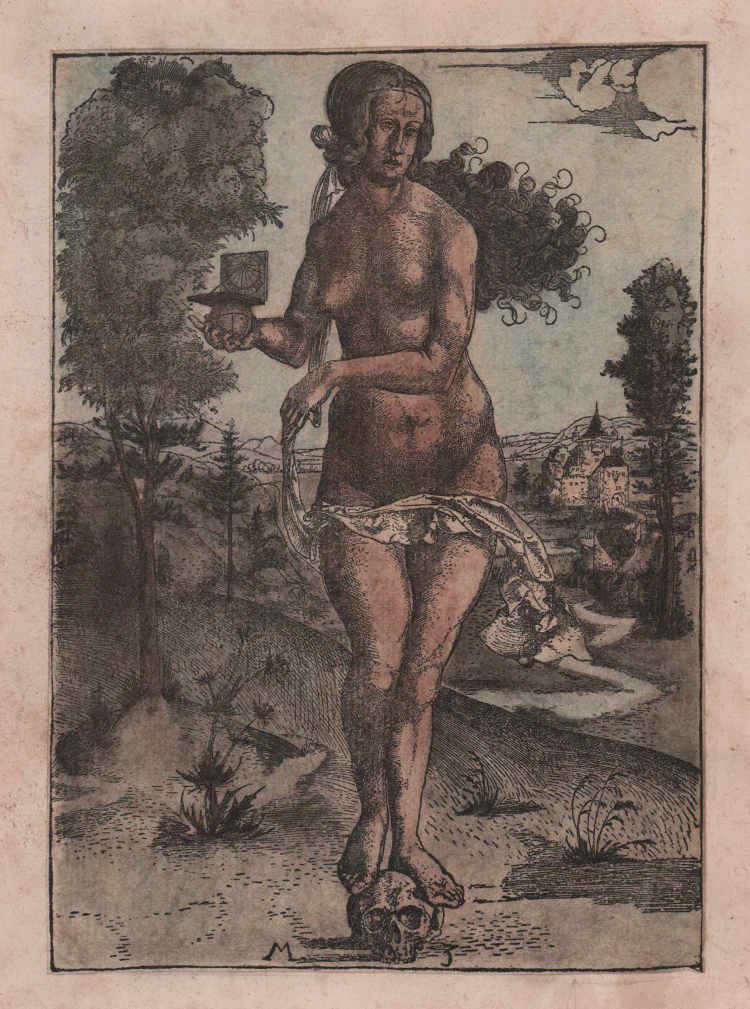



| Reference: | S48894 |
| Author | Martin ZASINGER (Maestro MZ) |
| Year: | 1500 ca. |
| Measures: | 125 x 178 mm |


| Reference: | S48894 |
| Author | Martin ZASINGER (Maestro MZ) |
| Year: | 1500 ca. |
| Measures: | 125 x 178 mm |
Seen from the front, a naked woman with long hair fluttering in the wind to the right stands on a skull and looks to the right. She holds a sundial on a sphere in her right hand and grasps the end of the veil falling from her head with her left. A lake with mountainous shores stretches out in the background. On the left rise hills with the high court, on the right is a water fort, connected to the land by a bridge. On either side a tall tree, the one on the left reaching to the upper edge of the picture. In the sky on the right some clouds. A thistle and two tufts of grass grow on the ground. Below, on both sides of the skull, the monogram.
Woodcut, circa 1500/1505, monogrammed MZ in tablet in lower center, with fine old colour.
Good proof, printed on contemporary paper without watermark, complete with marginal line, applied to antique mount, in very good condition.
The work reproduces the engraving made by Master MZ between 1502 and 1503, described by Bartsch and Lehrs. This is the example of th eengraving preserved in the Albertina in Vienna:
In cataloging the engraved work of the monogrammer MZ, the two reference books do not describe woodcut work, listing twenty-two engravings with the monogram MZ, including six dated between 1500 and 1503. This work may be a copy by contemporary hand or even his only example of work in woodcut. In either case we feel confident in saying that this is very rare work.
Vanitas, a Latin word for inanity, is an ephemeral concept that refers to the volatility of life on earth. This idea is associated with different objects, mainly from domestic and daily works, which gain a symbolic connotation. The element that mostly characterizes this representation is the skull, i.e. the memento mori which recalls the destiny of mankind. Other classical elements are the hourglass, the watch and the cedar, all of them standing for the passing of time; the cup, the jug or the bowl overturned represent inanity; the crown, the sceptre, the jewels and money represent power and earthly possessions that will be lost by the time we die; finally, the sword reminds that nothing can be done against destiny.
In the absence of appreciable stylistic or technical development, Zasinger’s production can be concentred around 1500. The prints are equally divided between religious and secular objects; most of his works have landscape backgrounds executed with a delicate touch that suggests a precursor of Albrecht Altdorfer and other painters of the Danube school. Works like The Ball and The Tournament (1500; Lehrs 17-18), companion pieces that represent a court festival in Munich, are the principal evidence that the artist was active in that city. This fact has supported the contention that Monogrammist MZ was the Munich goldsmith Matthäus Zasinger (1498-1555), though the burin work more readily suggests the hand of a painter than that of an engraver.
Bibliografia
Cfr. Bartsch vol. 6, pag. 379, 17; Lehrs p. 373 n. 20 e tav. 592.
Martin ZASINGER (Maestro MZ) (Monaco 1477 - 1509?)
|
The identification of the monogrammist MZ with the Munich goldsmith, Matthäus Zaisinger, or Zasinger, first mentioned in the seventeenth century, has been widely, but not universally, accepted. The name of Matthäus Zaisinger or Zazinger is connected to the prints of Master MZ from very early, in the list of his prints made by the Nuremberg collector Paul Behaim in 1618, which survives. Behaim calls Master MZ "Matheus Zaszinger" or "Zingel", without giving any reasons. Joachim von Sandrart included MZ in his Teutsche Academie of 1675, suggesting the initials stood for Martin Zink, Zatzinger or Zasinger. A Matthäus Zagel has also been introduced to the debate. Subsequently, records of Matthäus Zaisinger (or Zaysinger) in Munich have been unearthed by scholars. These cover such a long period (active 1498-1555 as printer, goldsmith & mint official) that there are probably two of them, presumably father and son. The earlier is often identified with Master MZ, but this remains speculative. A surviving engraved piece of metalwork, the back of a reliquary dated 1501, is thought to be by Zaisinger. Twenty-two engravings are accepted as Master MZ works. Master MZ is one of the earliest and most original engravers to have been influenced by the prints of the young Albrecht Dürer.
|
Martin ZASINGER (Maestro MZ) (Monaco 1477 - 1509?)
|
The identification of the monogrammist MZ with the Munich goldsmith, Matthäus Zaisinger, or Zasinger, first mentioned in the seventeenth century, has been widely, but not universally, accepted. The name of Matthäus Zaisinger or Zazinger is connected to the prints of Master MZ from very early, in the list of his prints made by the Nuremberg collector Paul Behaim in 1618, which survives. Behaim calls Master MZ "Matheus Zaszinger" or "Zingel", without giving any reasons. Joachim von Sandrart included MZ in his Teutsche Academie of 1675, suggesting the initials stood for Martin Zink, Zatzinger or Zasinger. A Matthäus Zagel has also been introduced to the debate. Subsequently, records of Matthäus Zaisinger (or Zaysinger) in Munich have been unearthed by scholars. These cover such a long period (active 1498-1555 as printer, goldsmith & mint official) that there are probably two of them, presumably father and son. The earlier is often identified with Master MZ, but this remains speculative. A surviving engraved piece of metalwork, the back of a reliquary dated 1501, is thought to be by Zaisinger. Twenty-two engravings are accepted as Master MZ works. Master MZ is one of the earliest and most original engravers to have been influenced by the prints of the young Albrecht Dürer.
|